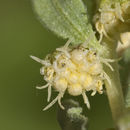Description
provided by eFloras
Perennials, 10–40(–60) cm (rhizomatous). Stems erect (usually herbaceous). Leaves: petioles 0–3 mm; blades narrowly ovate or obovate to elliptic or spatulate, 15–25(–45) × 3–8(–15) mm, margins rarely toothed, faces usually ± strigose to scabrellous, gland-dotted. Heads in ± racemiform arrays. Peduncles 1–2 mm. Involucres ± hemispheric, 2–3 mm. Phyllaries: outer 3–5 ± connate, ± herbaceous. Paleae linear, 1.5–2 mm. Pistillate florets 3–5(–8); corollas 0.5–1.5 mm. Functionally staminate florets 4–8(–20+); corollas 2–2.5 mm. Cypselae 2.5–3 mm. 2n = 36, 54.
- license
- cc-by-nc-sa-3.0
- copyright
- Missouri Botanical Garden, 4344 Shaw Boulevard, St. Louis, MO, 63110 USA
Synonym
provided by eFloras
Iva axillaris var. robustior Hooker
- license
- cc-by-nc-sa-3.0
- copyright
- Missouri Botanical Garden, 4344 Shaw Boulevard, St. Louis, MO, 63110 USA
Comprehensive Description
provided by North American Flora
Iva axillaris Pursh, Fl. Am. Sept. 743. 1814
Iva foliolosa Nutt. Trans. Am. Phil. Soc. II. 7: 346. 1840.
Iva axillaris pubescens A. Gray, in Torr. Bot. U. S. Expl. 17: Exp. 350. 1874.
Iva axillaris normalis Kuntze, Rev. Gen. 348. 1891.
Iva axillaris brevifolia Kuntze, Rev. Gen. 348. 1891.
Iva axillaris linearifolia Kuntze, Rev. Gen. 348. 1891.
A perennial, with a creeping rootstock, woody only at the base; stems ascending, 3-6 dm. high, striate, strigose or hirsute; branches simple, erect; lower leaves opposite, those of the inflorescence alternate, all subsessile, oblong, elliptic, or obovate, obtuse, entire, indistinctly triple-ribbed, hirsute; heads in leafy racemes, solitary in the axils of the floral leaves, which are similar to and not much smaller than the foliage leaves; involucre hemispheric, about 5 mm. broad; bracts 4 or 5, more or less united into a cup, rounded at the apex; paleae subtending the pistillate flowers oblong-spatulate, the inner ones oblanceolate or narrow with spatulate tips; staminate flowers about 20; corolla funnelform; anthers with acute tips; style short; stigma capitate, penicillate; pistillate flowers 5-8; achenes obovate, somewhat rounded, trigonous, glandular-muriculate. about 3 mm. long.
/. foliolosa Nutt. is a stout form of the Northwest with large heads and less deeply lobed involucre; /. axillaris pubescens A. Gray, is one from San Francisco south, with long loose pubescence.
Type locality: "Upper Louisiana" [North or South Dakota].
Distribution: Saline soil, from Saskatchewan to British Columbia, California, and New Mexico.
- bibliographic citation
- Per Axel, Rydberg. 1922. CARDUALES; AMBROSIACEAE, CARDUACEAE. North American flora. vol 33(1). New York Botanical Garden, New York, NY
Iva axillaris: Brief Summary
provided by wikipedia EN
Iva axillaris, called povertyweed or death weed, is a North American species of flowering plants in the family Asteraceae. It grows in the western and central United States and in western Canada, from British Columbia south to California and east as far as the western Great Plains in the Texas Panhandle, Nebraska, the Dakotas, and Manitoba. It has also become established in Australia, where it is considered a weed.
Iva axillaris is a wind-pollinated herb up to 60 cm (2 feet) tall, spreading by means of underground rhizomes. It has many small, lance-shaped leaves rarely more than 45 mm (1.8 inches) long. Flowers are set in the axils of the leaves rather than congregated at the tips of branches as in related species. Each head can contain 9-12 florets. Flowers bloom May to October.
- license
- cc-by-sa-3.0
- copyright
- Wikipedia authors and editors

